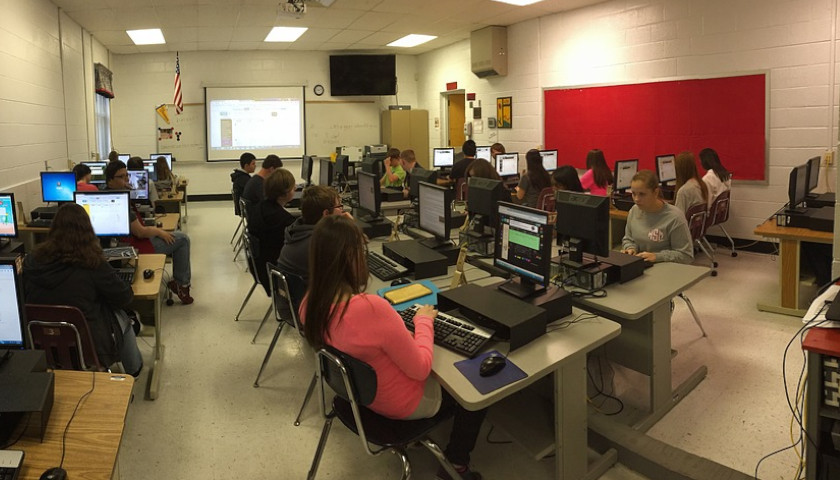According to a state commission report that studied education funding for fiscal year 2017-2018, the combined state and local government funding exceeded the Basic Education Program (BEP) funding formula by $2.1 billion.
The report, “K-12 Public Education Funding and Services,” was prepared by the Tennessee Advisory Commission on Intergovernmental Relations (TACIR) at the request of then Chairman of the House Finance, Ways and Means Committee Charles Sargent in April 2018.
TACIR was created by the General Assembly in 1978 in response to a need for a permanent intergovernmental body to study and take action on questions of organizational patterns, powers, functions and relationships among federal, state and local governments.
TACIR consists of 25 members, including state and local government officials as well as private citizens.
The staff of about two dozen, with an annual salary cost of about $2 million, includes seven in the office of the executive director, ten researchers, four research consultants and a senior public policy consultant.
TACIR’s K-12 education funding report, which reviewed the 2017-2018 fiscal year running July 1, 2017, through June 30, 2018, was released in January 2020.
The BEP formula was laid out in the Education Improvement Act of 1992, although with its few imposed earmarks to local school boards, it is “properly characterized as a funding formula, not a spending plan,” says the report.
Revenues in fiscal 2017-2018 for K-12 public education totaled $10.2 billion, $1.2 billion from the federal government, $4.9 billion from the state and $4.1 billion from local governments.
At 95 percent, nearly all state revenues local school systems receive is through the BEP formula, which also requires a level of local matching funds for Tennessee’s 141 public school systems.
Of the $2.1 billion of funding above and beyond the BEP formulate requirements, $400 million was from the state, while $1.7 billion was local revenue.
TACIR’s report goes on to say that at $1,396 per student, Tennessee spends only 75 percent of the $1,959 national average per student.
What the TACIR report doesn’t mention is that Tennessee – recently ranked by U.S. News & World Report number one for fiscal stability – has spending on K-12 education as a percentage of all expenditures at 20.6 percent against a national average of 21.5 percent, according to National Center for Education Statistics.
TACIR reports that meeting local needs as well as requirements by the state and federal governments often requires more resources than the BEP formula provides.
The four categories and the split for state and local funding, while varied over time, are currently set as follows:
Instructional salary – 70 percent state, 30 percent local
Instructional benefits – 70 percent state, 30 percent local
Classroom – 75 percent state, 25 percent local
Non-classroom – 50 percent state, 50 percent local
A table in the TACIR report shows that over a ten-year period, the total split of BEP funding is consistently 65 percent from the state and 34 percent from local governments, the difference being in fractional percentages. The report does not, however, indicate whether the percentages are reflective of the splits over the four categories.
The required local match is based on each county’s ability to raise local revenue for education – in other words, the county’s fiscal capacity – in a process called equalization and is based on models calculated by TACIR and the University of Tennessee’s Center for Business and Economic Research.
Fiscal capacity, however, is calculated at the county level not the school system level, resulting in funding disparities in counties with more than one school system, and there have been models developed – although not adopted – to deal with the situation.
Local funding beyond the required matches for BEP and other state and federal programs, the TACIR report says, also includes “locally identified education needs and community expectations.”
Examples cited in the TACIR report of those locally identified education needs and community expectations include field trips, categorized as academic enrichment as well as extracurricular activities such athletics, band and academic teams.
The report goes on to state that school systems hire more staff than provided in the BEP formula, thereby requiring additional local revenues.
The report jumps to the 2018-2019 fiscal year to provide details on the employed positions versus those funded by BEP.
In that year, 62,888 licensed instructional positions were funded in the 2018-2019 BEP formula, while school systems actually employed a total of 69,633.
Calculations by the Tennessee Department of Education (DOE) indicate it would have cost the state an additional $416.1 million to fund the balance of 6,745 positions.
The chart provided in the report shows 22 different types of licensed instructional positions. Of those, six were funded through the BEP at a higher level than were actually employed. While the total number of positions was adjusted through the use of negative numbers, the dollars were not likewise adjusted.
The average per position cost, extrapolated from the DOE chart provided, is $43,910. Total positions funded by BEP but allocated elsewhere within the school systems totals 2,731. The total is about $120 million.
The chart states the “State Cost to Fund Positive Differences” is $416 million, the operative words being “positive differences.”
The net cost – $416 million less the $120 million for positions employed but allocated elsewhere – is $296 million, or about nearly 29 percent less than stated in the report.
State funding for K-12 education funding has increased since the BEP formula implementation in fiscal year 1992-1993 from $1.6 billion to $4.9 billion 2017-2018, with the largest increase of $639.9 million occurring in 2016.
The Basic Education Program Review Committee (BEPRC), established in 1992 to make recommendations on the BEP formula, is required to meet at least four times each year.
The 2019-2020 BEPRC members number 22 and include the Commissioner of Education Penny Schwinn; Commissioner of Finance and Administration Stuart McWhorter; six members of public school systems in the state; the Chairs of the Senate and House Education Committees, Senator Dolores Gresham (R-Somerville) and Representative Mark White (R-Memphis); the executive director, chair and vice chair of the State Board of Education; Executive Director of TACIR; Comptroller of the Treasury Justin Wilson; and members of the tax-payer funded lobbying groups Tennessee School Board Association (TSBA) and Tennessee Organization of School Superintendents (TOSS).
Since 2004, the BEPRC has reported recommended changes to the BEP formula, some of which have been implemented, and others that have not.
As funding has increased, new programs and standards regularly come up, creating an ever-increasing demand for funding.
Examples of more recent programs and standards competing for resources include Response to Instruction and Intervention (RTI2), enhanced school safety through resource officers, decreasing the student to nurse, counselor and technology coordinator ratios and reduction in class size.
At the local level, all but four of the state’s 141 school systems exceeded the required local match of the BEP for a total of $1.72 billion.
Meanwhile, local school systems’ reserves have been growing as well.
In the five year period from fiscal year 2013-2014 to 2017-2018, fund balances across the districts have increased 2.5 times, from $412 million to over $1 billion, according to the Tennessee Department of Education Annual Statistical Reports.
—
Laura Baigert is a senior reporter at The Tennessee Star.









The real problem with public schools is the age old “solution” of throwing good money after bad without accountability. Until requirements on performance are imposed instead of wishing and hoping. The costs and failures will continue to escalate. I for one and sick and tired of pouring money down the public education rt hole. And Governor Lee just wants to keep pouring gasoline onto the fire.